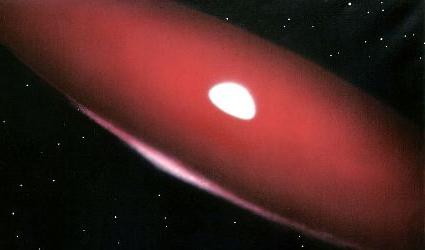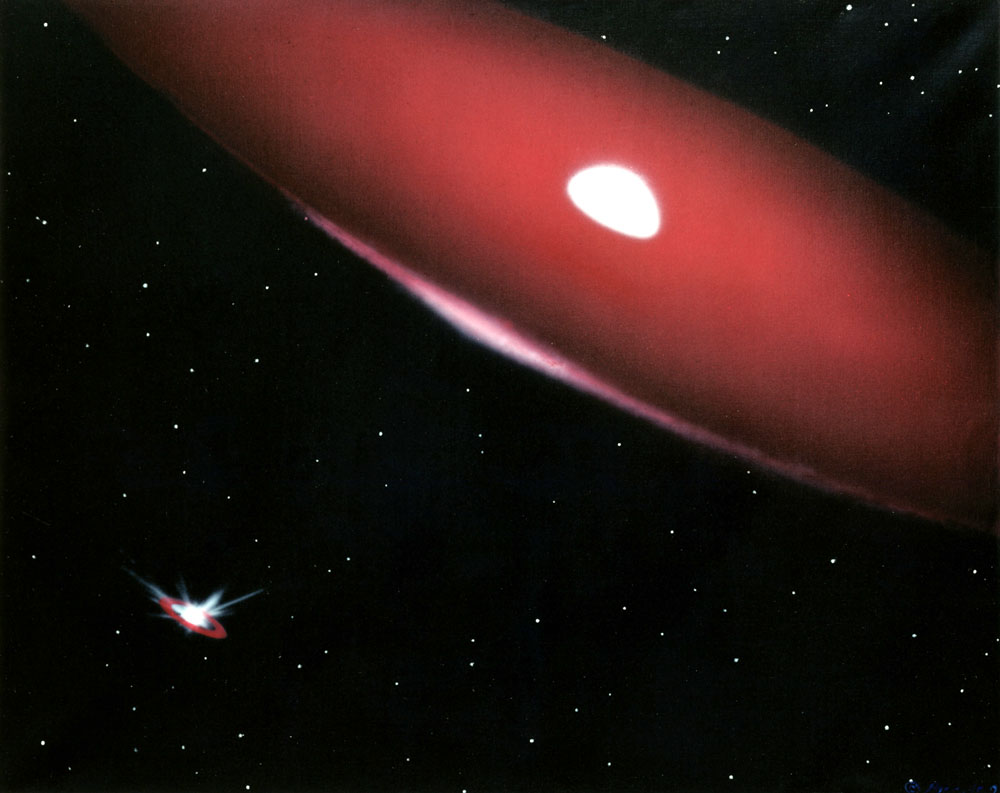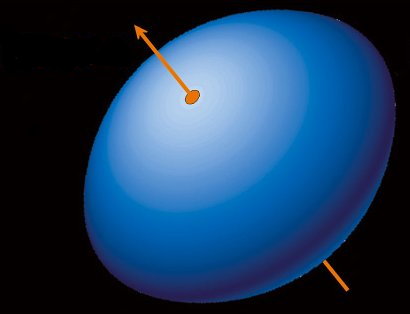Be star
A Be star or OeBeAe - star is a former star of luminosity class V, IV, or III (ie not super giant ), at least temporarily shows emission lines in the Fraunhofer lines, which. Identified by the suffix e for engl emission lines is given behind the B for the spectral type.
Definition
In about 15% of the early stars with spectral types O to A emission lines are stored in the nuclei of the first Balmer lines and the lines simply ionized elements of the iron, silicon and magnesium. The hydrogen lines occurs within the emission to a central depression. Another characteristic of Be stars is the large width of the photospheric absorption lines, which are the result of high rotational velocities at the stellar surface, with values between 200 and 500 km / s. This corresponds to 70-80% of the speed at which the centrifugal forces at the equator beyond the gravitational force. The high rotation speed also results in an asymmetry of the star wind. Due to the strong flattening of the star, the poles are hotter than the equator and the outflowing matter is strongly accelerated by the intense radiation field. All Be stars show a strong infrared excess. Linear polarization of up to 2% have been observed in the emission lines of certain loading star and are interpreted as a result of electron scattering in the non-spherical circumstellar shell.
Be stars are divided into classical Be stars and Be - shell stars. During loading star can not narrow absorption lines of the Balmer series of metal lines, which are referred to as a sheath lines, these can be detected during loading star shell. Probably the distinction is purely geometrical, conditional on looking through the inclination angle of the observer on the axis of rotation of blue stars.
Interpretation
The emission lines arise in optical thin shells that form along the equator of the star and thus lead to a temporarily stationary ring. The Be stars are in the Hertzsprung -Russell diagram in the beta Cephei stars and in recent years, multi- periodic radial and non-radial pulsations in Be stars have been found. The rings are a consequence of a resonance of closely spaced radial oscillations in combination with the high rotational speed of the early stars, so that both effects together lead to a separation of matter in the region of the equator. The ring is rotated, due to the greater distance from the star slower than the rating interface (see Kepler's law ), and therefore the emission lines are only in the nuclei of the absorption lines. From the analysis of the spectrum of Be stars an average density in the rings between 1010 to 1013 hydrogen atoms per cm3 was derived in an envelope mass of 10-10 solar masses.
The high rotational velocity of Be stars could be the result of a recent interaction with a companion in a binary star system, available now as a compact object in the form of a neutron star, white dwarf, or black hole. This hypothesis would also explain the high number of X-ray binaries among Be stars. Alternatively, the Be stars may have been born with a fast rotation rate or the rapid rotation have obtained during the main sequence phase. The ratio between the rotational speed and the critical speed at which the centrifugal force exceeds gravitational appears to be dependent on mass. Probably due to the high rotational speed of Be stars an extended main sequence phase because hydrogen is mixed into the core of the star.
EE Cephei is a rapidly rotating (350 km / s) B5Ve star, which forms a binary star system with an invisible companion, which in turn is circumscribed by a precessing against the railway axis dust disk, similar to Epsilon Aurigae. The dust disk seen covered by the earth from the Be star with a period of 5.6 years and the precession are each other parts of the star by the approximate gray lens covers. Therefore, in EE Cephei the polar radius and the equatorial radius to the 7.3 and the 10.6 times the solar radius with high accuracy could be determined. The dust disk around the unseen companion, was probably formed from material of abgeströmtem B5Ve star.
Variability
Be stars show a pronounced variability in the intensity of the emission lines, the emission lines from time to time also can not be detected as Pleione in 1905 to 1938. Along with a variability in the spectrum can also be a change in the optical brightness of the star, as in the example of gamma Cassiopeiae. Since the early stars leave the main part of the radiation in the ultraviolet, the cooler rings can absorb energy and re-emit in the optical.
The variable Be stars are also referred to as a shell star or gamma Cassiopeiae - Stars ( GCVS designation GCAS ), where brightness changes in the visuals to up to 2.5 mag. In outburst, the spectral type can cool up to F5. This corresponds to a temperature of about 6800 K, while undisturbed B star denotes a surface temperature 10000-25000 K. Probably a large part of the surface of the star during the outbreak of a curved plate is covered. The curvature is the result of a non-rotating in the rotational plane companion compact (eg neutron star ) and the resulting tidal effects. The cause of the different orbital plane, an asymmetric supernova explosion is assumed in the formation of the neutron star.
V / R variations
In many Be stars variations in the strength of the blue - (V) and red-shifted (R ) emission lines have been found. Correlated with the changes in the emission lines also varies the degree of polarization. The V / R variations are considered a deviation from the axial symmetry in the ring around the Be star interpreted. The cause could be a vibration in the disk around the early star, which is triggered by gravitational resonance due to the circulation of a companion to the Be star.
Be stars in X-ray binaries
Be stars are often the mass donor in HMXB (English High Mass X -ray binaries, high-mass X-ray binaries ). Here, a neutron star orbiting the Be star in a mostly elliptical orbit. If the neutron star far away, then it accretes little matter, and the impact on its surface after the fall by the gravitational field only little X-rays are free. If the neutron star with the circumstellar ring around the Be star into contact as this can increase the X-rays through the transfer of more gas or weaken. A weakening occurs when the matter is so dense in the ring that the resulting neutron star at the X-ray radiation is absorbed in the ring again. The temporary formation of rings or shells around Be stars is often the cause of irregular variable X-ray radiation in HMXBs. During a accretion is the X-ray radiation of the most stars BeXB - pulsed with a period length of a few seconds up to a minute. This is to be concealed a consequence of the flow of matter along magnetic field lines of the neutron star, which due to the rotation of the star, the bremsstrahlung emitting regions over the magnetic poles periodically visible or.
From Be / X - ray binaries bursts are observed, which are classified based on the duration of the eruptions in type I and type II bursts. Type I bursts take a small share of rail orbital period of the binary system and reach X-ray luminosities up to 1037 erg / s Because of their occurrence near the periastron passage in an elliptical orbit is a Akkretionsereignis during immersion of the neutron star in the circumstellar disk around the Be star. The type II bursts, however, can last for several Bahnumläufe and reach X-ray luminosities greater than 1037 erg / s Your cause is seen in a suggestion of a geneigenden against the web revolution axis washer to be the star by the passing companion.
Of the BeXB ( Be stars in X-ray binaries ), the γ - Cas -star distinction. They show a weaker X-rays than normal BeXB with a harder spectrum. This term describes a larger proportion of short-wave to long-wave X-rays. Furthermore show γ - Cas - stars no Röntgenpulsationen, which are interpreted as a consequence of a strong magnetic field on a neutron star. Due to the similarity of the X-ray spectrum of γ - Cas - stars with those of cataclysmic variables has been suggested that the optically detectable companion is a white dwarf, respectively. However, it is difficult to understand how a white dwarf in orbit around a B star is formed, since the enhanced star have been even more massive than the B star must and is therefore explodes as a supernova. For a supernova explosion but forms a neutron star or black hole. The alternative is that the γ - Cas - stars are not X-ray binaries. This assumption is also supported by the absence of modulation of the X-ray light curve with the orbit of the hypothetical white dwarf. However, show all γ - Cas -star a spectral type between B0 and B1 5, 5 with an intense Hα emission line with an equivalent width of 30 to 40 angstroms. This very similar stellar parameters indicate a different cause for the emergence of X-rays. Therefore, it is assumed that it is in a magnetic field in the slice of the loading star circumstellar due to the differential rotation of the magnetic short circuit. By short-circuiting flares arise similar to some solar flares, which also use X-ray radiation exposure.
Supersoft X -ray sources are white dwarfs in binary systems, in which it is on the surface of white dwarfs for hydrogen burning. Most Supersoft X -ray Sources occur in cataclysmic variables as a result of a nova outburst in which the mass -donating companion star of the white dwarf is a red dwarf or a subgiant later. However, a Be star accrete enough matter also in rare cases a white dwarf from the stellar wind or from the disk to first be accumulated on its surface. After a few years, when the matter has reached an appropriate density, ignites the nuclear reaction and from the thin atmosphere of the white dwarf soft X-ray radiation is emitted.
Analysis of the optical light curves show a range of time scales in the variability of the Be / X binaries. These include radial and non-radial vibrations of the atmosphere of the loading star with periods of between 0.1 and 2 days. Superpositions of these pulsations can show of some 100 days periods and are then difficult to separate from the orbital period in the range of 10 to 500 days. The latter brightness variations are interpreted as a disturbance of the circumstellar disk by the compact companion or the formation of a temporary accretion disk around the neutron star. There is also variability in the order of several years, which are probably due to irregularities in the circumstellar disk. An example of such a disorder is a bending of the pulley due to a resonance between the web of the neutron star and the circulation time in the circumstellar disk.
Development models
In the course of further development, the Be star expands, whereby the rotational speed decreases while maintaining the torque and the Decretionsscheibe disappears. However, the rapid rotation changes the chemical composition of the star, since due to the meridional flow more hydrogen-rich material was transported into the nucleus. This leads to a higher core mass of the former Be stars in comparison with slowly rotating stars of spectral type B. It is assumed that Be stars evolve into luminous Strengthening Blue Variables for this property. Massive Be star could be after Kollapsarmodell also the progenitor star of gamma -ray bursts of long duration.
B [ e] star
From the Be stars, the B [ e] stars are distinguished which are sometimes referred to as BQ -star or as Bep stars. They are described as stars with early spectral types with low stimulated emission lines, forbidden lines and signs of warm dust in the near and mid-infrared. Their characteristics are:
- The presence of broad Balmer lines, some of which also show P- Cygni profiles with half-widths of up to 1000 Angstroms
- Emission lines of allowed transitions of singly ionized metals, mostly FeII
- Narrow emission lines with forbidden transitions of [ FeII ] and [ OI]
- In a multi-color diagram in the infrared, the stars form a separate group
The main difference of the B [e ] stars to the Be stars is the lack of any signs of warm dust around Be stars. B [e ] stars are further divided into normal and B [e ] supergiants. The former are probably objects with low luminosity, which develop from an AGB star to a planetary nebula. The outer atmosphere is still bloated and reemitiert the radiation even at temperatures that are not yet sufficient to excite the cast-off shell. However, the B [ e] - phenomenon is associated also with the Herbig-Ae/Be-Sternen that are only on the way to the age -zero main sequence. Probably the B [ e] stars are a very heterogeneous group.
The B [e ] supergiants are stars in Nachhauptreihenstadium with luminosities from 104 to 106 times the sun. They also show a high rotational speed, which also is the cause of the wahrschinelich circumstellar disc from dust and molecules. The shape of a disk has been inferred from polarimetric measurements and the shadowing by a dense disk also explains the coexistence of ionizing radiation from the hot atmosphere of a B star and the presence of dust and molecules. If they were directly exposed to such radiation, they should be destroyed by photoevaporation within a short time. B [e ] supergiants are regarded as predecessors or by other sources as the successor of light Strengthening Blue Variables or as the result of a merger in a binary star system. Also, many B [ e] sg are variable with periods of a few hundred to 10 days and are thus similar to the interacting binary systems such as the Beta - Lyrae stars, the W Serpentis stars and the double periodic variables. The properties of the disk of some B [e ] supergiants can be best described as a Kepler disk interpret a binary star system. The companion of over Riesens is only indirectly detected via radial velocity changes. A scientific consensus on the issue of formation of B [ e] - supergiants but has not yet been reached.
B [ e] star with a luminosity class IV or V are also referred to as FS CMa stars. It is probably around evolved stars that are still close to the main sequence and usually occur in a binary star system. Their properties are explained as a consequence of a slow equatorial and polar of a fast stellar wind with a speed of some 100 km / s, which provides a dust ring forms around the equator. In the equatorial outflow disk, which flows only at a speed of some 10 km / s, the emission lines of hydrogen and low- excited metals form. The emission lines of highly excited metals arise, however, in the polar regions where the stellar wind absorpiert less UV radiation because of its low density.










